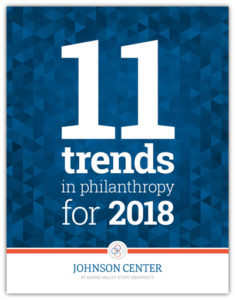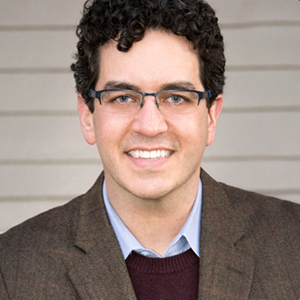The Globalization of Philanthropy


Download and read the full report, featuring all 11 trends, here.
 Most giving is local and will likely remain so for a long time (Giving USA 2017). But in an increasingly connected world, we are seeing the spread of shared, formal philanthropic practices across borders. More and more, philanthropy around the world is adopting similar — often westernized — structures, policies, and strategies. This globalization is visible in myriad ways, from the standardization of giving vehicles and the continued growth of community philanthropy, to the expansion of support organizations and global peer donor networks.
Most giving is local and will likely remain so for a long time (Giving USA 2017). But in an increasingly connected world, we are seeing the spread of shared, formal philanthropic practices across borders. More and more, philanthropy around the world is adopting similar — often westernized — structures, policies, and strategies. This globalization is visible in myriad ways, from the standardization of giving vehicles and the continued growth of community philanthropy, to the expansion of support organizations and global peer donor networks.
First, we are seeing the creation of western-model charitable foundations in regions where such entities were previously uncommon or absent. This development is often driven by a desire to learn and adopt best practices from places (like the U.S. and Europe) where foundations have long been institutionalized. Yet this standardization is tempered by local cultural and societal norms, and by legal, regulatory, and economic systems.
Community philanthropy is following a similar pattern of growth: collective giving is on the rise globally, yet individual communities are adapting practices to local culture and leadership. Between 2000 and 2010, the number of community foundations worldwide grew by 86 percent, with an average of 70 institutions created annually (Knight, 2014). Similar growth among giving circles, another popular form of community philanthropy, is also evident across the globe, from the U.S. and Europe to Asia and the Pacific islands (Bearman, Carboni, Eikenberry, & Franklin 2017; Harvey, 2016; John, 2017).
The American philanthropic sector’s growing interest in supporting nonprofit capacity is also playing out globally. New organizations that support the philanthropic sector are taking shape, and transnational organizations are seeing a rise in international membership and participation in their gatherings (Knight & Ribeiro, 2017).
Finally, as wealth accumulation continues globally, we’re witnessing the emergence and expansion of global peer donor networks. These networks bring like-minded donors together around a variety of common interests. Perhaps the most well know of these is the Giving Pledge, which engages some of the world’s wealthiest families.
While practices are spreading, wide variations remain, including differences in vehicle preferences, charitable deductibility, government regulation of giving practices, and, increasingly, threats around restricting civil society and philanthropic behavior (Firmin, 2017).
To the extent that this globalization is leading to the spread of proven best practices, cross-border learning, cultivation of new donors, and improved support for philanthropy in new places, there is much to celebrate. But with globalization inevitably comes the possible displacement of diverse and indigenous philanthropic practices and traditions. Critics of this globalization are right to point out the danger of a sort of new philanthropic colonialism. Moving forward, the challenge facing our global sector is to increase philanthropy worldwide while respecting cultural traditions and unique local practices.


Bearman, J., Carboni, J., Eikenberry, A., & Franklin, J. (2017). The landscape of giving circles/collective giving groups in the U.S. Grand Rapids, MI: Collective Giving Research Group. Retrieved from http://johnsoncenter.org/wp-content/uploads/2017/11/Giving-Circles-Research-Full-Report-1-WEB.pdf
Firmin, A. (2017, February). Contested and under pressure: A snapshot of the enabling environment of civil society in 22 countries. Geneva, Switzerland: Civicus: World Alliance for Citizen Participation. Retrieved from https://www.civicus.org/images/EENA_Report_English.pdf
Giving USA. (2017) The annual report on philanthropy for the year 2016, 62nd annual issue. Chicago, IL: Giving USA Foundation.
Harvey, E. (2016). The Funding Network: Connecting need with resources to strengthen communities around the world. London: The Funding Network. Retrieved from http://bit.ly/2iFO1aR
John, R. (2017). Circles of influence: The impact of giving circles in Asia. Singapore: Asia Centre for Social Entrepreneurship & Philanthropy. Retrieved from http://bschool.nus.edu.sg/images/ACSEP/Research-Papers/2017/Entrepreneurial-Social-Finance-in-Asia-Working-Paper-6.pdf
Knight, B. (2014). Community Foundation Atlas: Dimensions of the field. Johannesburg: Global Fund for Community Foundations. Retrieved from http://communityfoundationatlas.org/facts/#analysis
Knight, B. & Ribeiro, P. (2017, February 22). Infrastructure in focus: A new global picture of organizations serving philanthropy. Quezon City, Philippines: Worldwide Initiatives for Grantmaker Support. Retrieved from https://www.issuelab.org/resource/infrastructure-in-focus-a-new-global-picture-of-organizations-serving-philanthropy.html